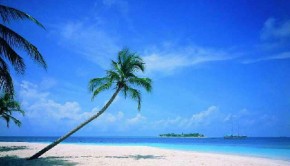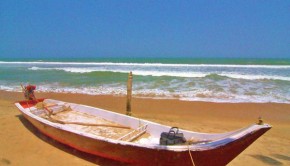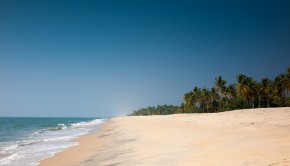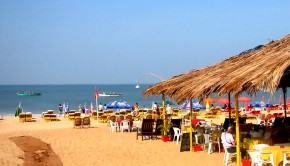Varkala Location:
Varkala is located between Alleppey and Kollam, around one hour north of Trivandrum (Thiruvananthapuram), in India’s southern state of Kerala.
Getting to Varkala:
Varkala cliff and beach are located a 10 minute drive away from Varkala town and railway station. Almost 20 Indian Railways trains stop at the station. If coming by train, take an auto rickshaw from the station for around 50 rupees ($1). Alternatively, there are airports at Trivandrum and Kochi (around 4 hours north of Varkala).
Varkala Weather:
Varkala’s climate is very tropical and humid. It receives rain from both the southwest and northeast monsoon, which produce intensely heavy downpours. The rain is at its worst from June to August, and late October to December. Late December to March are the best months to visit, when the weather is dry and sunny every day, and the temperature hovers around 30 degrees Celcius (86 degrees Fahrenheit). The summer months of April and May become very humid and hot, with temperatures around 35 degrees Celcius (95 degrees Fahrenheit).
Varkala Attractions:
Varkala is a wonderful place to relax and rejuvenate. It’s well known for its dramatic sunsets. Settle into one of the beach shacks with a drink, and you’ll have an uninterrupted view of the sun as it slowly sinks down the horizon. The mineral spring that flows from the cliff at the southern end of the beach is believed to have medicinal properties. You’ll also find plenty of places specializing in yoga, and Ayurvedic massage and therapies. The Scientific School of Yoga, Naturopathy and Ayurveda Hospital is reputable. Sun Moon Project & East West Connection is recommended for reiki and energy healing. Meditation and art/creative workshops are also offered. Shop ’til you drop at the endless rows of huts lining the cliff, stocking everything from jewelry to handicrafts. The Janardhana Swamy Temple festival is held every March.
Varkala Beaches:
Varkala’s main beach is called Papanasam Beach — which means destroyer of sins. The beach is divided into two parts, with the southern area at the end of the road leading from the Janardhana Swamy Temple considered sacred to Hindus. It’s where they come to perform the last rites after close relatives have died. The tourist part of the beach is located further north, past the mineral spring, at the bottom of the cliff. There’s also another small beach with black sand near the coconut grove where the cliff ends in the far north, past Papanasam Beach.
 Varkala Hotels:
Varkala Hotels:
Varkala has accommodations to suit all price ranges, from resorts to simple rooms in family homes. If you feel like splurging, Palm Tree Heritage, on quieter Odayam beach around 10 minutes walk from the cliff, has top quality rooms from 4,000-9,000 rupees. Varkala Marine Palace, at the south end of the cliff, has rooms, cottages and apartments from 1,000-5,000 rupees per night. The Green Palace is a popular and centrally located on the north end of the cliff next to Cafe Del Mar, with rates from 2,000-4,000 rupees a night. Keratheeram Beach Resort is a highly rated budget option on the cliff, with rooms from 300-1,000 rupees a night, depending on the time of year. Set back from the cliff, the very attractive Kaiya House is a boutique hotel run by a lovely foreigner-Indian husband and wife team. Expect to pay around 2,000 rupees a night. For a romantic retreat away from the action, you can’t go wrong at the boutique Villa Jacaranda, on a hill near the Indian end of Papanasam Beach.
 Varkala Nightlife:
Varkala Nightlife:
The nightlife in Varkala is quite laid back. Some beach shacks, such as Rock n Roll, do have parties and play music late into the night. However the party scene is restricted by complaints from nearby hotels about the noise, and also the prohibition of alcohol. As Varkala is a holy town, none of the beach shacks are licensed to serve alcohol, although this doesn’t stop them from doing so after paying adequate compensation to the local police. Other nightlife includes traditional Kathakali dance performances in the evenings.
Varkala Dangers and Annoyances:
Varkala has undergone a dramatic amount of growth in just few years to be transformed from sleepy village into sought after beach destination. This has had a significant impact on the locals. Females should take particular care around local men, as incidents of drunkenness and groping are common. Many foreign women also end up being charmed by the staff from the beach shacks, who usually end up wanting money or are married. Begging and hawking are becoming issues as well. Also bring a flashlight as power cuts are prevalent. At the beach, swimmers should be aware of strong currents and not swim out too far.

Varkala Travel Tips:
An important thing to keep in mind is the interesting tide pattern at Varkala. This sees Papanasam Beach completely immersed in the ocean during the monsoon season, while the black beach is accessible. After the monsoon, this trend reverses with the black beach becoming engulfed in water and Papanasam Beach open.
During the monsoon season it’s therefore best to stay at the northern end of the cliff near the black beach, while in peak season, the southern end of the cliff provides the easiest access to Papanasam Beach as the stairs leading down the cliff are located there. This end of the cliff is also quieter.
It’s cheaper to stay away from the cliff, at the Indian southern end of Papanasam Beach, however the cliff isn’t easily accessible from
this area (which suits people who want to avoid the crowds!). The Indian end of Papanasam Beach also remains isolated from the tourist part of the beach until the monsoon fully retreats and the beach completely opens up. Therefore if you want to go up to the cliff from there, it’s necessary to take an auto rickshaw
.
 Varkala Hotels:
Varkala Hotels: Varkala Nightlife:
Varkala Nightlife:

 Stunnigly picturesque Varkala beach provides a relatively peaceful alternative to the now commercialized Kovalam. The setting of this beach is striking enough to take your breath away, with a long winding stretch of cliff and views that extend over the Arabian Sea. A paved footpath runs along the length of the cliff, bordered by coconut palms, quaint shops, beach shacks, hotels, and guest houses. Nestled at the bottom of the cliff is a long stretch of sparkling beach, reached by steps leading down from the cliff top.
Stunnigly picturesque Varkala beach provides a relatively peaceful alternative to the now commercialized Kovalam. The setting of this beach is striking enough to take your breath away, with a long winding stretch of cliff and views that extend over the Arabian Sea. A paved footpath runs along the length of the cliff, bordered by coconut palms, quaint shops, beach shacks, hotels, and guest houses. Nestled at the bottom of the cliff is a long stretch of sparkling beach, reached by steps leading down from the cliff top.













Pingback: Jerry
Pingback: Gregory
Pingback: ernest
Pingback: Francisco
Pingback: Darrell
Pingback: calvin
Pingback: Joe
Pingback: Justin
Pingback: Don
Pingback: jordan